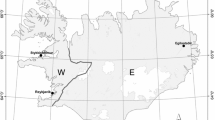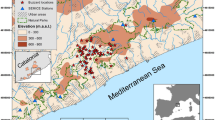Abstract
Arctic foxes Vulpes lagopus (L.) display a sharp 3- to 5-year fluctuation in population size where lemmings are their main prey. In areas devoid of lemmings, such as Iceland, they do not experience short-term fluctuations. This study focusses on the population dynamics of the arctic fox in Iceland and how it is shaped by its main prey populations. Hunting statistics from 1958–2003 show that the population size of the arctic fox was at a maximum in the 1950s, declined to a minimum in the 1970s, and increased steadily until 2003. Analysis of the arctic fox population size and their prey populations suggests that fox numbers were limited by rock ptarmigan numbers during the decline period. The recovery of the arctic fox population was traced mostly to an increase in goose populations, and favourable climatic conditions as reflected by the Subpolar Gyre. These results underscore the flexibility of a generalist predator and its responses to shifting food resources and climate changes.




Similar content being viewed by others
References
Angerbjörn A, Hersteinsson P, Lidén K, Nelson E (1994) Dietary variation in arctic foxes (Alopex lagopus)—an analysis of stable carbon isotopes. Oecologia 99:226–232
Angerbjörn A, Tannerfeldt M, Erlinge S (1999) Predator–prey relationships: arctic foxes and lemmings. J Anim Ecol 68:34–49
Arnalds O, Barkarson BH (2003) Soil erosion and land use policy in Iceland in relation to sheep grazing and government subsidies. Environ Sci Policy 6:105–113
Bantle JL, Alisauskas RT (1998) Spatial and temporal patterns in arctic fox diets at a large goose colony. Arctic 51:231–236
Box GEP, Jenkins GM (1976) Time series analysis: forecasting and control, revised edn. Holden-Day, Merrifield
D´Alba LL, Monaghan P, Nager RG (2010) Advances in laying date and increasing population size suggest positive responses to climate change in common eiders Somateria mollissima in Iceland. Ibis 152:19–28
Dýrmundsson Ó, Hallgrímsson S (1978) Reproductive efficiency of Iceland sheep. Livest Prod Sci 5:231–234
Eide NE, Eid PM, Prestrud P, Swenson JE (2005) Dietary responses of arctic foxes Alopex lagopus to changing prey availability across an Arctic landscape. Wildl Biol 11:109–121
Elton C (1924) Periodic fluctuations in the numbers of animals: their causes and effects. Br J Exp Biol 2:119–163
Fewster RM, Buckland ST, Siriwardena GM, Baille SR, Wilson JD (2000) Analysis of population trends for farmland birds using generalized additive models. Ecology 81:1970–1984
Fooks AR, Roberts DH, Lynch M, Hersteinsson P, Runólfsson H (2004) Rabies in the United Kingdom, Ireland and Iceland. In: King AA, Fooks AR, Aubert M, Wandeler AI (eds) Historical perspectives of rabies in Europe and the Mediterranean Basin. World Organisation for Animal Health, Paris, pp 25–32
Forschhammer MC, Post E, Stenseth NC, Boertmann DM (2002) Long-term responses in arctic ungulate dynamics to changes in climatic and trophic processes. Popul Ecol 44:113–120
Frafjord K (1993) Food habits of arctic foxes (Alopex lagopus) on the western coast of Svalbard. Arctic 49–54
Gardarsson A (2006) Recent changes in numbers of cliff-breeding seabirds in Iceland. Bliki 27:13–22
Gauthier G, Bêty J, Giroux JF, Rochefort L (2004) Trophic interactions in a high arctic snow goose colony. Int Comp Biol 44:119–129
Gilg O, Sittler B, Sabard B, Hurstel A, Sané R, Delattre P, Hanski I (2006) Functional and numerical responses of four lemming predators in high arctic Greenland. Oikos 113:193–216
Gilg O, Sittler B, Hanski I (2009) Climate change and cyclic predator–prey population dynamics in the high Arctic. Glob Change Biol 15:2634–2652
Gillings S, Austin GE, Fuller RJ, Sutherland WJ (2006) Distribution shifts in wintering golden plover Pluvialis apricaria and lapwing Vanellus vanellus in Britain. Bird Study 53:274–284
Giroux MA, Berteaux D, Lecomte N, Gauthier G, Szor G, Bêty J (2012) Benefiting from a migratory prey: spatio-temporal patterns in allochthonous subsidization of an arctic predator. J Anim Ecol 81:533–542
Gunnarsson E, Hersteinsson P, Adalsteinsson S (1993) Rannsóknir á sjúkdómum í íslenska melrakkanum (Studies on diseases in the Icelandic arctic fox). In: Hersteinsson P, Sigbjarnarsson G (eds) Villt íslensk spendýr (e. Reykjavík, Wild Icelandic Mammals), Hið íslenska náttúrufræðifélag, pp 49–58
Hátún H, Hersteinsson P, Adalsteinsson S (2005) Influence of the Atlantic Subpolar Gyre on the thermohaline circulation. Science 309:1841–1844
Hearn RD (2000) The 1999 national census of pink-footed geese and Icelandic greylag geese in Britain and Ireland. Report to JNCC. The Wildfowl and Wetlands Trust, Slimbridge, p 14
Hearn RD (2002) The 2000 national census of pink-footed geese and Icelandic greylag geese in Britain and Ireland. Report to JNCC. The Wildfowl and Wetlands Trust, Slimbridge, p 15
Hearn RD (2003) The 2001 Icelandic-breeding goose census. A Wildlife and Wetlands Trust Report, Slimbridge, p 16
Hearn RD (2004) The 2002 Icelandic-breeding goose census. Wildlife and Wetlands Trust Research Report, Slimbridge, p 15
Hersteinsson P (1984) The behavioural ecology of the Arctic fox (Alopex lagopus) in Iceland. PhD dissertation, Department of Zoology, University of Oxford, Oxford
Hersteinsson P (1988) When is the den hunting of arctic foxes most successful? Wildl Manage News (Iceland) 7:5–13
Hersteinsson P (1992) Demography of the arctic fox (Alopex lagopus) population in Iceland. In: McCullough DR, Barrett RH (eds) Wildlife 2001: populations. Elsevier, London, pp 954–964
Hersteinsson P (1996) Lamb consumption by Arctic foxes in Iceland. In: Macdonald DW, Tattersall FH (eds) The WildCRU review: the tenth anniversary report of the Wildlife Conservation Research Unit at Oxford University. WildCRU, Oxford, pp 148–151
Hersteinsson P, Macdonald DW (1992) Interspecific competition and the geographical distribution of red and arctic foxes Vulpes vulpes and Alopex lagopus. Oikos 64:505–515
Hersteinsson P, Macdonald DW (1996) Diet of Arctic foxes (Alopex lagopus) in Iceland. J Zool 240:457–474
Hersteinsson P, Björnsson T, Unnsteinsdóttir ER, Ólafsdóttir AH, Sigthórsdóttir H, Eiríksson T (2000) The Arctic fox in Hornstrandir: number of dens occupied and dispersal of foxes out of the reserve. Náttúrufræðingurinn 69:131–142
Hersteinsson P, Yom-Tov Y, Geffen E (2009) The effect of the Sub-polar Gyre, North Atlantic Oscillation and ambient temperature on size and abundance in the Icelandic Arctic fox. Clim Change Biol 15:1423–1433
Hurrell JW (1995) Decadal trends in the North Atlantic Oscillation: regional temperatures and precipitation. Science 269:676–679
Ims RA, Fuglei E (2005) Trophic interaction cycles in tundra ecosystems and the impact of climate change. Bioscience 55:311–322
Ingólfsson A (1975) Life on seashores. Rit Landverndar 4:61–99
Jepsen JU (2002) The importance of prey distribution in habitat use by arctic foxes (Alopex lagopus). Can J Zool 80:418–429
Jóhannsson JH, Gudjónsdóttir B (1995) Atlas of breeding birds in Steingrímsfjörður and vicinity, NW-Iceland: a survey 1987–1994. Fjölrit Náttúrufræðistofnunar 28:1–76
Jónsson ÁÁ (1998) Foxes and minks. In: Jónsson ÁÁ (ed) Veiðidagbók 1998. Wildlife Managment Institute, Akureyri, pp 3–5 (in Icelandic)
Jónsson JE, Gardarsson A, Gill JA, Petersen AE, Gunnarsson TG (2009) Seasonal weather effects on the common eider, a subarctic capital breeder, in Iceland over 55 years. Clim Res 38:237–248
Kaikusalo A, Angerbjörn A (1995) The arctic fox population in Finnish Lapland during 30 years, 1964–1993. Ann Zool Fenn 32:69–77
Krebs CJ, Boutin S, Boonstra R, Sinclair ARE, Smith JNM, Dale MR, Martin K, Turkington R (1995) Impact of food and predation on the snowshoe hare cycle. Science 269:1112–1115
Krebs CJ, Boutin S, Boonstra R (2001) Ecosystem dynamics of the boreal forest. The Kluane Project. Oxford University Press, New York
MacDonald MA (1980) The winter attendance of fulmars at land in NE Scotland. Ornis Scand 11:23–29
Mitchell C, Sigfússon A (1999) Greylag goose Anser anser: Iceland. Goose populations of the Western Palearctic. In: Madsen H, Cracknell G, Fox AD (eds) A review of status and distribution. National Environment Research Institute, Rønde, pp 162–171
Mitchell C, Fox AD, Boyd H, Sigfússon A, Boertmann D (1999) Pink-footed goose Anser brachyrhynchus: Iceland/Greenland. Goose populations of the Western Palearctic. In: Madsen H, Cracknell G, Fox AD (eds) A review of status and distribution. National Environment Research Institute, Rønde, pp 68–81
Newth J (2007) Status and distribution of Icelandic-breeding geese: results of the 2006 international census. Wildfowl and Wetlands Trust report, p 19
Nielsen SM (1991) Fishing Arctic Foxes Alopex lagopus on a rocky island in West Greenland. Pol Res 9:211–213
Nielsen ÓK, Einarsson Ó (2004) A massive mid-winter wreck of alcids in Iceland. Náttúrufrædingurinn 72:117–127
Nielsen ÓK, Pétursson G (1995) Population fluctuations of gyrfalcons and rock ptarmigan: analysis of export figures from Iceland. Wild Biol 1:65–71
Nielsen ÓK, Brynjarsdóttir J, Magnússon KG (2004) Monitoring the ptarmigan population 1999–2003. Fjölrit Náttúrufræðistofnunar 47:1–110
Pedchenko AP (2005) The role of interannual environmental variations in the geographic range of spawning and feeding concentrations of redfish Sebastes mentella in the Irminger Sea. ICES J Mar Sci Jour Conseil 62:1501–1510
Petersen A (1998) Íslenskir fuglar. Vaka-Helgafell, Reykjavik
Pinheiro JC, Bates DM (2000) Mixed-effects models in S and S-PLUS. Springer, New York
Prestrud P (1992) Food habits and observations of the hunting behaviour of arctic foxes, Alopex lagopus, in Svalbard. Can Field Nat 106:225–236
Pyper BJ, Peterman RM (1998) Comparison of methods to account for autocorrelation in correlation analyses of fish data. Can J Fish Aquat Sci 55:2127–2140
Quinn G, Keough M (2002) Experimental design and data analysis for biologists. Cambridge University Press, Cambridge
R Core Team (2015) R: a language and environment for statistical computing. R Foundation for Statistical Computing, Vienna, Austria. https://www.R-project.org/
Roth JD (2003) Variability in marine resources affects arctic fox population dynamics. J Anim Ecol 72:668–676
Rowell HE (2005) The 2004 Icelandic-breeding goose census. The Wildfowl and Wetlands Trust report, Slimbridge, p 19
Rowell HE, Hearn RD (2005) The 2003 Icelandic-breeding goose census. The Wildfowl and Wetlands Trust/Joint Nature Conservation Committee report, Slimbridge, p 18
Samelius G, Alisauskas RT, Hobson KA, Larivere S (2007) Prolonging the arctic pulse: long-term exploitation of cached eggs by arctic foxes when lemmings are scarce. J Anim Ecol 76:873–880
Sinclair AR, Gosline JM, Holdsworth G, Krebs CJ, Boutin S, Smith JN, Boonstra R, Dale M (1993) Can the solar cycle and climate synchronize the snowshoe hare cycle in Canada? Evidence from tree rings and ice cores. Am Nat 141:173–198
Snæthorsson AÖ (2011) Saga og útbreiðsla fýls í Jökulsárgljúfrum. Bliki 31:11–14
Statistics Iceland (2006) web page: http://www.statice.is/Statistics/Fisheries-and-agriculture. [Accessed 26 August 2006])
Stenseth NC, Mysterud A (2005) Weather packages: finding the right scale and composition of climate in ecology. J Anim Ecol 74:1195–1198
Vibe C (1967) Arctic animals in relation to climatic fluctuations. Meddelser Grønland 170(5):227
Worden J (2006) Status and distribution of Icelandic-breeding geese: results of the 2005 international census. Wildfowl and Wetland Trust report, Slimbridge, p 19
Acknowledgments
This study was partly funded by the Science Research Fund of Iceland, the Ministry of the Environment, Iceland, and the Natural History Institute of Iceland. Thanks are due to all the fox-hunters who supplied material for the study in spite of no financial compensation. J. H. Jóhannsson and B. Guðjónsdóttir most graciously supplied unpublished data on breeding Fulmars. A. Angerbjörn and A. Gardarsson kindly read and criticised an early draft of this manuscript. Thanks to the editor and two anonymous reviewers for constructive comments.
Author Contribution Statement
P. H. and O. K. N. conceived and designed the initial study. P. H. and S. P. analysed the data. P. H., S. P., E. R. U. and O. K. N. wrote the manuscript.
Author information
Authors and Affiliations
Corresponding author
Additional information
Communicated by Anders Angerbjörn.
Electronic supplementary material
Below is the link to the electronic supplementary material.
Rights and permissions
About this article
Cite this article
Pálsson, S., Hersteinsson, P., Unnsteinsdóttir, E.R. et al. Population limitation in a non-cyclic arctic fox population in a changing climate. Oecologia 180, 1147–1157 (2016). https://doi.org/10.1007/s00442-015-3536-7
Received:
Accepted:
Published:
Issue Date:
DOI: https://doi.org/10.1007/s00442-015-3536-7




